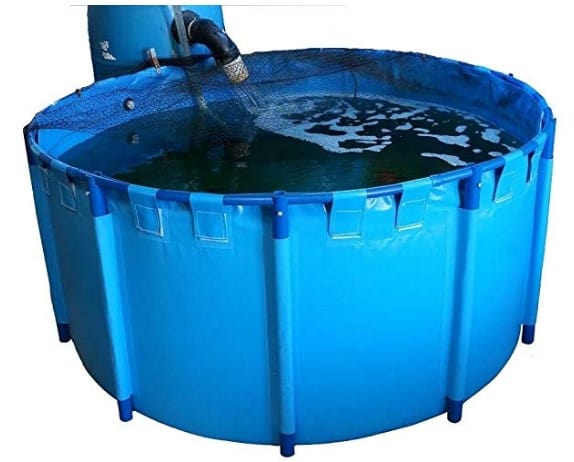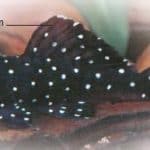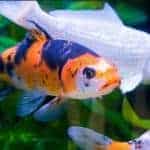Koi Fish Tank Size Keep mature koi in an outdoor pond of at least 3 feet deep, with at least 50 gallons of water per fish. Young koi can be kept indoors in an aquarium of at least 29 gallons.
A good rule of thumb to go by for ponds or larger koi tanks is 250-gallons per koi fish. A koi pond with 5 fish will need to be 1250-gallons and at least 3-feet deep.
A Koi Fish minimum tank size probably shouldn’t be less than 50 gallons for as little as two or three fish. It doesn’t seem like much but if these fish even just get
These are good portable koi fish tanks you can easily setup this is good for koi fish tanks breeding and koi fish tanks for quarantine
Intex Mini Frame Pool
Have fun splashing and playing in the Intex Mini Frame Pool.
Includes: Foam padded horizontal beams for comfort, drain plug & repair patch kit
Age: 3+ years
Approximate size: 48” x 48” x 12”
Water capacity: 89 gallons (9-1/2” of wall height)
Product description
Cool off in the summer time with this Intex Mini Frame Pool. Set up size is 48″ x 48″ x 12″. Galvanized metal steel frame. Foam padded horizontal beams for comfort.
Your Choice Aquatics Round Koi Pond Show Tank 98.4″ x 39.4″ (1297gal)
Product description
This portable holding tank feature easy assembly and disassemble. This free standing tank is ideal for shows, quarantine or temporary quarters. T
he material is extremely strong and completely fish friendly. Highly tear resistant. Technical Specifications:
Liner is UV resistant PVC support legs Thickness is approximately 0.6mm 2 holes: top hole is 3/4″ and bottle is 3/4″ comes with plugs Comes with extra patches and glue to fix leak Koi filter and net are not included Assembly required
koi fish tanks What size tank do you need for a koi fish?
koi fish tanks

So, if our 125-gallon tank will hold 1.25 12-inch koi, then it will hold 11 6-inch koi (1.25 X 9 = 11).
It is essential to realize that as the koi fish grow, you will have to remove koi fish from the koi fish tank to maintain the proper load balance.
Can you put a koi fish in a tank?
Keep koi fish in large aquariums for a few months at a time. If you live in an apartments, you may have to keep koi in aquariums for their entire life.
That is possible, as long as you do not overcrowd the aquarium with too many koi. … Your tank should have 1 cubic foot per 1 inch of koi fish length
Obtain an aquarium that is large enough to contain the number of koi you have.
Koi need a large volume tank to thrive. Your tank should have 1 cubic foot per 1 inch of koi fish length.
Multiple the tank’s height by width by length to determine the tank’s cubic footage.
Put the aquarium on a stand that can support the weight of the tank, and find a location in your home that can accommodate the weight of the tank safely, such as near a support wall or on a concrete basement floor.
Place a substrate layer at the bottom of the tank at least 2 inches deep. Use a mixture of small gravel and larger gravel or rock pieces. Koi are bottom-feeders, and will enjoy sifting through the substrate.
Install an external filter to the aquarium that is made for the number of gallons in your tank. You may choose to use a carbon filter, as well, to remove toxins and impurities in the water.
Install an aquarium heater to regulate the temperature. Although koi fish can withstand water below 40 degrees and above 80 degrees, koi kept indoors should have a heater regulating the temperature to 68 to 77 degrees. That will maintain the metabolism at a good level.
Keep an koi aquarium cover on top of the tank at all times to prevent koi fish from jumping out. Use a cover with a light inside since koi fish also need 12 hours of light a day.
Test the water’s pH regularly. Koi like a neutral pH between 7 and 9. Add pH stabilizer to the tank water if the pH gets too low.
Perform partial water changes weekly. Remove 10 to 20 percent of the tank water and then top off the tank with tap water, adding dechlorinator to the new water before pouring it into the tank.
Well water not been treated with chlorine may not need a dechlorinator.
However, let the well water sit out for several hours, and then test the pH. Treat the water with pH stabilizer if it is below 7.
Feed the koi fish only what they can eat in five minutes. Overfeeding will pollute the water.
How many gallons of water does a koi fish need?
We generally offer two rules of thumb regarding the number of koi in a pond or koi fish tank . First, average water conditions will allow 1 inch of fish per 10 gallons of water (or 100 inches for a 1,000-gallon pond).
Do koi fish grow to the size of their koi fish tank?
There is an element of truth to this, but it is not as innocent as it sounds and is related more to water quality than koi fish tank size.
When properly cared for, koi fish will not stop growing. Most fishes are in fact what are known as indeterminate growers. This means that, unlike humans, they grow until they die.
Though their growth rate when they are about 3 years old up will be slower compared to their 0 to 1 years age.
How much space does a koi fish need?
Koi fish should be stocked based on a reasonable estimate of their full growth, not on their size at purchase.
Most well-maintained koi ponds will support 1″ of fish per ten gallons of water.
Though some koi in the largest ponds will grow to 36″, we recommend using an average of 21″.
How long does it take for a koi fish to grow to full size?
The oldest koi was 226 when it died in the 1970s indeed one of the longest living vertebrate ever recorded) was a beautiful scarlet coloured female Koi called ‘Hanako’ (pronunced hah-nah-koh; translated as ‘Flower Maid’).
it can take more than 10 years to get to full size.
Basically if you raise them the cheap American way, in a backyard pond or a mini pool at a Chinese restaurant, you can expect to keep them for about 30 years and get foot long fish.
Can I keep a koi fish in a tank?
Koi are cold water pond fish, descended from carp. … Keep koi in large aquariums for a few months at a time.
If you live in an apartments, you may have to keep koi in aquariums for their entire life.
That is possible, as long as you do not overcrowd the aquarium with too many koi.
What size tank does a koi fish need?
Koi grow quickly and get very large. Keep mature koi in an outdoor pond of at least 3 feet deep, with at least 50 gallons of water per fish. Young koi can be kept indoors in an aquarium of at least 29 gallons.
Can koi fish live with other fish?
Koi are generally peaceful. They may, however, pick on slow-moving fish such as fancy goldfish.
Since they are cool water fish, they generally should not be housed in an aquarium with Tropical Fish.
Koi can be overwintered in the pond in most areas of the country if the water is at least 3 feet deep.
Can koi fish live without oxygen?
Koi breathe by pumping water over their gills to extract dissolved
oxygen from the pond water.
Depending on their activity level, koi require varying amounts of oxygen.
But depending on your fish load and pond size, plants and a
fountain often aren’t enough – especially during the summer
How much water do koi fish need?
We generally offer two rules of thumb regarding the number of koi in a pond. First, average water conditions will allow 1 inch of fish per 10 gallons of water (or 100 inches for a 1,000-gallon pond).
What’s the best food for koi fish?
Best Koi Food Reviews
TetraPond Floating Koi Sticks. …
Kaytee Koi’s Choice Premium Fish Food. …
Tetra Pond Pond Sticks, Healthy Nutrition for Goldfish and Koi. …
HARTZ Wardley Pond Floating Fish Food Pellets. …
Hikari Gold Pellets Pond Fish Food. …
Laguna All Season Goldfish & Koi Floating Food.
How long can koi fish go without food?
Many experienced fishkeepers routinely leave their charges for two
to three days without making any provisions for feeding.
Almost any fish can go that long without fish food (more about that later, as well).
Do koi fish grow to their tank size?
There is an element of truth to this, but it is not as innocent as it
sounds and is related more to water quality than tank size.
When properly cared for, goldfish will not stop growing. Most fishes are in fact what are known as indeterminate growers.
This means that, unlike humans, they grow until they die.
Can you keep koi with goldfish?
Kept well, goldfish can live in your pond for well over 15 to 20 years. If you have a very large pond, you can also keep goldfish and koi together.
If you have a large pond, you have the option of keeping koi. Koi can grow very large, up to 3 feet, and they can weigh up to 40 pounds.
Will Koi eat smaller fish?
Koi carp are unlikely to eat other large fish, including large goldfish. However, if something will fit in their mouths then they may well try to eat it! So smaller goldfish will be at risk. Koi will also eat fish eggs.
Buy koi fish for sale philippines
how to sanitize fish tanks koi
If you’re introducing koi to an existing school in an aquarium or pond, … Do not use soaps or detergents to clean aquarium or décor, since they are toxic to fish.
koi fish minimum tank size
50 gallons
Mature koi, the 36” long fish that we often see in koi ponds, need at least 50 gallons apiece.
This means that 4 koi that large can only be kept in a 200 gallon tank, and that’s the minimum.
If you want the fish to be healthy and able to grow, then a 12” koi should be kept in a 100 gallon tank.
How big of a tank do you need for a koi fish?
Koi grow quickly and get very large. Keep mature koi in an outdoor pond of at least 3 feet deep, with at least 50 gallons of water per fish. Young koi can be kept indoors in an aquarium of at least 29 gallons.
Can you keep small koi in a tank?
If you live in an apartments, you may have to keep koi in aquariums for their entire life. That is possible, as long as you do not overcrowd the aquarium with too many koi. … Koi need a large volume tank to thrive. Your tank should have 1 cubic foot per 1 inch of koi fish length.
Buy koi fish painting for sale here
koi fish tanks People also ask
Can koi fish live in a tank?
Koi are cold water pond fish, descended from carp. … Keep koi in large aquariums for a few months at a time.
If you live in an apartments, you may have to keep koi in aquariums for their entire life. That is possible, as long as you do not overcrowd the aquarium with too many koi.
how to sanitize fish tanks koi
Can you keep koi in a fish tank?
Koi are cold water pond fish, descended from carp. … Keep koi in large aquariums for a few months at a time. If you live in an apartments, you may have to keep koi in aquariums for their entire life. That is possible, as long as you do not overcrowd the aquarium with too many koi
indoor koi fish tanks
Young koi can be kept indoors in an aquarium of at least 29 gallons. Put the aquarium in a quiet area out of direct sunlight and drafts.
Cover the aquarium with a hood to reduce evaporation and splashing and to keep fish from leaping out
koi fish holding tanks
A variety of fish holding tanks which can be used as fish quarantine tanks, portable fish pools, Koi vats and Koi tanks. Holding tanks are commonly used
koi fish care in tanks
Keep mature koi in an outdoor pond of at least 3 feet deep, with at least 50 gallons of water per fish. Young koi can be kept indoors in an aquarium of at least 29 gallons. Put the aquarium in a quiet area out of direct sunlight and

Your Choice Aquatics Round Koi Pond Show Tank 98.4″ x 39.4″ (1297gal)
Buy this at Amazon.com
keeping koi in fish tanks
freshwater fish that look like koi but can be kept in tanks
koi fish pond separation tanks
Koi fish are colored carp that live in man made ponds. … Members take their Koi from their ponds and place them into tanks to enter their fish in the show. The Koi are separated by type and size and then are judged on body conformation and
can koi live in fish tanks
Koi grow quickly and get very large. Keep mature koi in an outdoor pond of at least 3 feet deep, with at least 50 gallons of water per fish. Young koi can be kept indoors in an aquarium of at least 29 gallons. Whether they live indoors or outdoors, add no more than 3 new koi at a time.
tanks for small koi fish
Will Koi outgrow a fish tank?
Small fish make indoor koi keeping possible. Unfortunately, koi grow rapidly during their first years. Even when purchased as a baby, it will outgrow its tank in about a year. … For this reason, most people who try indoor ponds either expand to the outdoors or stop altogether, since house koi also require more care
can koi fish outgrow their tanks,
can discus fish live with koi fish tanks,
can koi fish live in small tanks,
koi fish meant for tank
Koi need a large volume tank to thrive. Your tank should have 1 cubic foot per 1 inch of koi fish length.
Although koi can withstand water below 40 degrees and above 80 degrees, koi kept indoors should have a heater regulating the temperature to 68 to 77 degrees. That will maintain the metabolism at a good level
inverted fish tanks koi ponds viewing
Creating An Inverted Aquarium For Pond | pond | Minimalist …
https://www.pinterest.com › pin
Huge inverted aquarium/ upside down fish tank ( part 1) – YouTube Aquarium Stand … Floating Fish Koi Pond Observatory Lets You View Your Fish Above The …
Man Places Upside Down Fish Tank In His Koi Pond With …
https://www.reshareworthy.com › upside-down-fish-tank
This pet owner has made it a point to make his pet Koi fish more comfortable in his garden pond and has created something that’s not only cool for the fish, it’s a
koi fish settlement tanks
Outdoor pond filter and settling tank | Outdoor ponds, Pond …www.pinterest.com › pin
The article gives a detailed analysis of The Need for a Koi Pond Filter System. Koi Pond Filter System A Koi is not your ordinary fish, it cannot thrive. Fish Ponds
large koi fish tanks
fish tanks for koi garden,
large fish tanks for koi fish
Koi grow quickly and get very large. Keep mature koi in an outdoor pond of at least 3 feet deep, with at least 50 gallons of water per fish. Young koi can be kept indoors in an aquarium of at least 29 gallons
koi fish breeding tanks
koi fish quarantine tanks
The quarantine tank can be a lot smaller than a pond because it will only be a temporary home for the Koi. Most quarantine tanks are 100 to 500 gallons in size. Larger size tanks are impractical for any Koi except the large jumbo varieties
keeping koi fish in tanks
Koi grow quickly and get very large. Keep mature koi in an outdoor pond of at least 3 feet deep, with at least 50 gallons of water per fish.
Young koi can be kept indoors in an aquarium of at least 29 gallons. Put the aquarium in a quiet area out of direct sunlight and drafts.
koi fish for small tanks
Koi get big – and no they won’t stay the size of the tank they are in. If you force a fish into a small system is stunts them and leads to a very early demise.
I would only recommend putting koi in a outdoor pond as they are a domesticated species of Cyprinus carpio and can get to an average size of three feet.
Is koi fish good for aquarium?Koi are cold water pond fish, descended from carp. … Keep koi in large aquariums for a few months at a time.
If you live in an apartments, you may have to keep koi in aquariums for their entire life. That is possible, as long as you do not overcrowd the aquarium with too many koi.
what fish can live with koi in a tank

8 Fish That Can Live With Koi In A Tank – Koi Tank Mates
Barbel (Barbus barbus)
Barbs (Barbus tetrazona)
Catfish (Siluriformes)
Goldfish (Carassius auratus)
Golden Orfe (ILeuciscus idus)
Tench (Tinca tinca)
Pleco (Hypostomus plecostomus)
Sturgeon (Acipenseridae)
how big should a tank be for two small koi fish|0ahukewizli-i0ovnahunhm0khfnxcvqq4dudcas

Koi grow quickly and get very large. Keep mature koi in an outdoor pond of at least 3 feet deep, with at least 50 gallons of water per fish. Young koi can be kept indoors in an aquarium of at least 29 gallons.
how to care for koi fish in a tank

Keeping koi in an aquarium requires lots of space per fish, frequent cleaning and adequate filtration. Room to Thrive.
